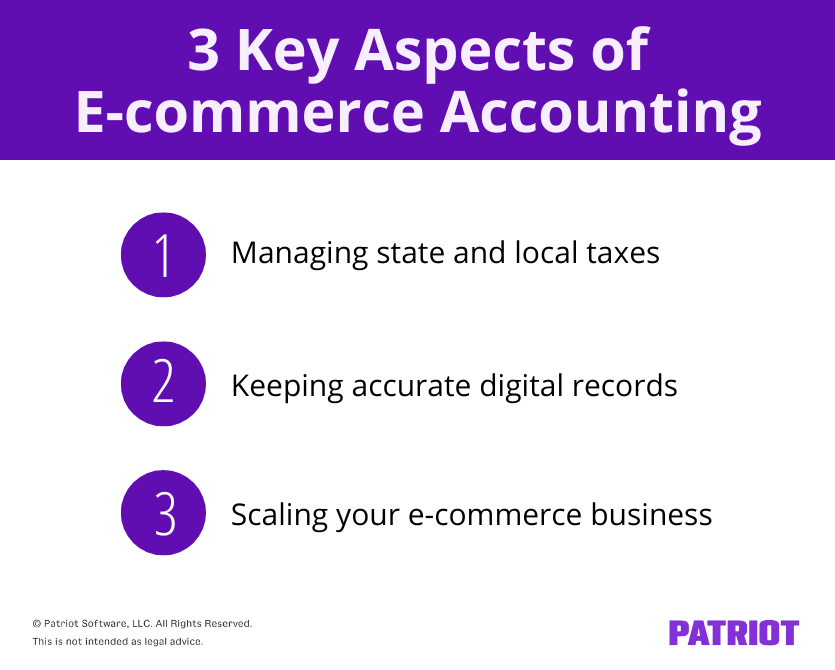Brick-and-mortar stores are still thriving, but small businesses’ online footprints expand every year. In 2022, 98% of business owners had a company website, compared to 50% in 2018. And more than 60% had an e-commerce business, meaning they sold products or services online. If you’ve been thinking about an online business, you need to know about e-commerce accounting. Read our guide to learn what you need to know.
Introduction to e-commerce accounting
What is e-commerce accounting? E-commerce accounting is when a business organizes and records the financial transactions related to its e-commerce company. E-commerce accounting is like business accounting, but since e-commerce transactions take place entirely online, there are several things you should keep in mind.

Accounting for an e-commerce business includes:
- Managing state and local taxes
- Keeping accurate digital records
- Scaling your e-commerce business
1. Managing state and local taxes
One of the great opportunities with an e-commerce business is expanding your customer base to different states. But new customer opportunities may bring some tax-law headaches.
Before 2018, businesses had to collect sales taxes in states where the company had sales tax nexus. A company’s tax nexus depended on its physical presence in a state. If your company had a warehouse, headquarters, or retail stores in a state, you had tax nexus in the state. But this all changed in 2018.
In 2018, the Supreme Court decided on South Dakota v. Wayfair. The Court’s decision changed how online businesses collected sales tax. Because of Wayfair, state sales tax laws are determined by the state. Now, states can create their own sales tax nexus laws to include e-commerce sales even if the seller doesn’t have a physical presence in the state.
You must follow the remote sales tax laws of the state where the customer lives, whether you have a physical presence in that state or not.
Remote sales tax laws for remote sellers
What is a remote seller? States consider any e-commerce company a remote seller unless they have a physical presence in the state. Physical presence can include an office, retail space, or a warehouse.
Unless you have a physical presence in a state, like an office, retail space, or warehouse, you are a remote seller in that state.
Sales tax thresholds for remote sellers may be based on sales, the number of transactions, or both. When using sales to establish a sales threshold, the state may focus on:
- Gross sales
- Gross revenue
- Retail sales
- Taxable sales
For example, if a customer in Colorado buys a product from your e-commerce store based in Mississippi, you’ll have to pay sales tax in Colorado if you meet the state’s threshold. The sales tax threshold in Colorado is triggered when you have more than $100,000 in annual taxable sales.
Remember that many states don’t distinguish between taxable and non-taxable sales when calculating a sales threshold.
How to follow sales tax laws for remote sellers
If you don’t take the right steps, sales tax laws for remote sales can quickly get out of hand. To run a successful e-commerce business, make sure you comply with state sales tax laws.
Here are five steps to make sure you understand your tax obligations as a remote seller:
- Find out if you’ve met the sales tax nexus requirements of a state
- Understand the policies of your marketplace facilitator (e.g., Amazon or Etsy)
- Get the right seller’s permits
- Collect and remit sales tax
- Stay compliant
2. Keeping accurate digital records
Accurate bookkeeping is another unique issue that e-commerce accounting must deal with. E-commerce bookkeeping is similar to the bookkeeping duties of a brick-and-mortar business. Still, there are a few significant differences to keep in mind.
Merchant fees and gross sales
If an e-commerce platform hosts your online store (e.g., Shopify), bank deposits will show the net sales from the platform rather than gross sales. Why does this happen? The e-commerce platform will take out its merchant fees before depositing the money in your account.
Remember, your e-commerce bookkeeping needs to show gross sales, sales tax, merchant fees, and the total amount deposited on your bank statement.
Sales tax
Some e-commerce platforms will collect revenue and sales tax from a customer purchase and deposit both into your bank account, a practice that can make e-commerce accounting complicated.
For instance, a customer makes a $40 purchase, but your e-commerce platform deposits $41.90 into your bank account. The $40 purchase has an 8% sales tax, making the total price $43.20 (40 x 0.08). And, the platform also takes out a merchant fee of 3% for $41.90 (43.20 x 0.03).
Make sure to separate the sales tax from the deposit total so you can give the right amount of taxes to the right tax authority. Also, your books should show the revenue from the sale, the merchant fee, and the sales tax separately.
Continuing with the previous example, your books should reflect:
- Gross revenue: $40
- Merchant fee: $1.30
- Sales tax: $3.20
Shipping fees
Shipping fees appear clear-cut to the customer. But with flat rate or free shipping, there can be differences between how much the customer pays for shipping and what you’re charged for shipping. In other words, there’s a difference between your income and your expenses.
For example, under a flat rate shipping fee system, two customers pay the same shipping fee of $5, regardless of how much you pay to ship their purchases. Shipping one package may cost you $8, while another may only cost you $2. The discrepancies between what you collect and what you charge for shipping result in either an income or an expense. The $2 shipping cost results in an income of $3 ($2 – $5), and the $8 shipping cost is an expense of $3 ($8 – $5).
A COGS Shipping Expense account can separate your shipping income and costs from other income and expense accounts. And if you wanted to keep an even closer eye on your shipping fees, you could have two separate accounts, a COGS Shipping Expense account, and a COGS Shipping Income account.
Third-party tools and refunds
If you use a payment processor (e.g., PayPal), customer returns and product exchanges can complicate your e-commerce bookkeeping. Customer want to return items for free—in fact, 67% of online customers expect it. Free returns can increase brand loyalty and customer spending by 158% – 457%.
But, some payment processors give you little say in how returns are processed or who pays for shipping.
When deciding on an e-commerce platform or a payment processor, research their return policies to know exactly who’s responsible for the refund and how to account for it.
Here are some questions you can ask:
- Does the payment processor return the merchant fee?
- Is the return tracked? If so, which company is responsible for tracking—the e-commerce platform or the payment processor?
- Does the payment processor help update your inventory?
- Does the return come with additional expenses you need to keep track of?
Tracking inventory across sales platforms
Diversifying your e-commerce platforms may make perfect sense for your business. After all, more sales channels mean more chances to make the sale. But, you could quickly lose track of your inventory across multiple sales channels.
Ecommerce inventory management software can fix this problem by helping you track inventory across sales channels.
If an inventory management system isn’t your style, here are a few things you can do to keep track of your e-commerce inventory:
Standardize and track product information. If you sell the same products across multiple sales channels, standardize product names, barcodes, SKUs, and other relevant information. Standardizing the information surrounding your products can help track them across sales channels.
Create an inventory protocol. An inventory protocol will help you or your team remain consistent. Here are a few things to think about addressing in your inventory protocol:
- Ordering and receiving stock
- Fulfilling customer orders
- Counting inventory across channels
- Handling returns
Regularly audit your inventory. If you can physically count your inventory, you should. Even though a physical count is time-consuming, it’s the best way to know exactly where your inventory stands. This doesn’t have to happen all the time, just once a year.
You may want to do partial counts throughout the year. If you count all at once, choose a slower period to conduct your inventory audit.
Track and analyze sales. It’s always smart to know your sales inside and out. Which products are selling? Where are our customers located? Knowing your sales can help you understand your inventory better and plan for future offers.
3. Scaling your e-commerce business
Starting your e-commerce store is a great feeling. But, the real excitement comes from scaling your business. Ecommerce accounting can make scaling your business simpler by helping you understand:
- The products and services that are most profitable
- Changes in profits over time
- The largest expenses and liabilities of your company
- Future opportunities to expand your profit margins
- Profit and loss statements
- The ins and outs of your cash flow
Running a small business is hard work. But with Patriot Software it can always be easier. Patriot’s accounting software helps you keep your time and money. And if you ever have any questions, our free USA-based support is always happy to help. Try it free today!



